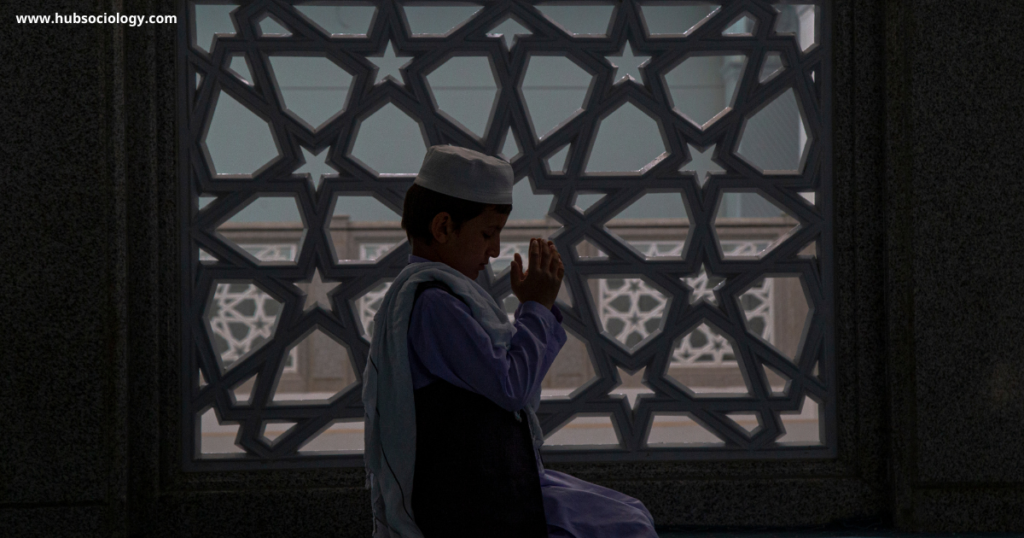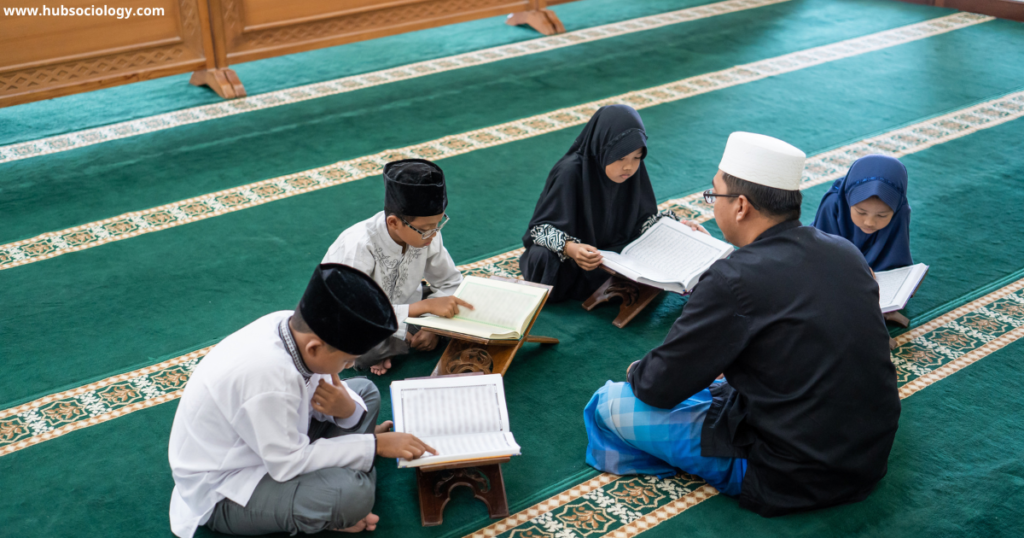India, a land of diverse cultures, religions, and traditions, has been a melting pot of social change and transformation over centuries. Among the many religions that have shaped its social fabric, Islam holds a significant place. Introduced to India in the 7th century through trade and later consolidated by various dynasties, Islam has played a pivotal role in shaping the socio-cultural, economic, and political landscape of the country. This article explores the relationship between Islam and social change in India from a sociological perspective, examining how Islam has influenced Indian society and how Indian society, in turn, has influenced the practice of Islam.

Historical Context: Islam’s Arrival and Early Influence
Islam arrived in India through Arab traders who settled on the Malabar Coast in the 7th century. However, it was the establishment of the Delhi Sultanate in the 13th century and later the Mughal Empire in the 16th century that marked the significant spread and institutionalization of Islam in India. The Mughal period, in particular, is often regarded as a golden age of cultural synthesis, where Islamic and Hindu traditions intermingled, giving rise to a unique Indo-Islamic culture.
From a sociological perspective, the arrival of Islam introduced new social structures, legal systems, and cultural practices. The caste system, which had been a dominant feature of Hindu society, was challenged by the Islamic emphasis on equality and brotherhood. Islam’s egalitarian principles offered a sense of dignity and social mobility to lower-caste Hindus, many of whom converted to Islam. However, it is important to note that over time, the caste system also influenced the Muslim community in India, leading to the emergence of social stratification among Indian Muslims.
Islam and Social Reform Movements
The 19th and early 20th centuries witnessed a series of social reform movements in India, many of which were influenced by Islamic thought. Leaders like Sir Syed Ahmed Khan, who founded the Aligarh Muslim University, sought to modernize the Muslim community by promoting Western education and scientific thinking. Khan’s efforts were aimed at bridging the gap between traditional Islamic teachings and the demands of a rapidly changing world.
Similarly, the Deoband movement, which emerged in the late 19th century, sought to revive Islamic teachings and resist Western cultural influences. While the Deobandis emphasized a return to traditional Islamic values, they also played a role in mobilizing Muslims against colonial rule, thus contributing to the broader Indian independence movement.
These reform movements highlight the dynamic interplay between Islam and social change in India. On one hand, Islam provided a framework for challenging existing social hierarchies and advocating for social justice. On the other hand, it also served as a means of preserving cultural identity in the face of colonialism and modernization.
Islam and the Struggle for Independence
The role of Islam in India’s struggle for independence cannot be overlooked. Muslim leaders like Maulana Abul Kalam Azad and Muhammad Ali Jinnah played crucial roles in the fight against British rule. Azad, a prominent Congress leader, advocated for Hindu-Muslim unity and a united India, while Jinnah, the leader of the All-India Muslim League, eventually pushed for the creation of Pakistan as a separate Muslim state.
The partition of India in 1947, which led to the creation of Pakistan, was a watershed moment in the history of Indian Islam. The mass migration of Muslims to Pakistan and Hindus and Sikhs to India resulted in significant social upheaval. For the Muslims who remained in India, the partition posed new challenges, including questions of identity, citizenship, and belonging.
Post-Independence: Islam and Social Change in Modern India
In the post-independence period, Indian Muslims have continued to navigate the complexities of social change. The Indian Constitution, which guarantees equality and freedom of religion, has provided a framework for the protection of minority rights. However, Muslims in India have often faced socio-economic marginalization, discrimination, and communal violence.
From a sociological perspective, the experiences of Indian Muslims in the post-independence era can be understood through the lens of identity politics. The rise of Hindu nationalism in recent decades has further complicated the social position of Muslims in India. Incidents of communal violence, such as the 2002 Gujarat riots and the 2019 Citizenship Amendment Act protests, have highlighted the ongoing tensions between religious communities.
Despite these challenges, Indian Muslims have also been active agents of social change. Organizations like the Jamiat Ulema-e-Hind and the All India Muslim Personal Law Board have sought to address issues related to Muslim personal law and education. At the same time, Muslim women’s movements have emerged to challenge patriarchal practices within the community, advocating for gender justice and reform.
Islam and Cultural Synthesis in India
One of the most significant contributions of Islam to Indian society has been its role in fostering cultural synthesis. The fusion of Islamic and Indian traditions has given rise to a rich cultural heritage, evident in architecture, music, literature, and cuisine. The Taj Mahal, a symbol of Indo-Islamic architecture, stands as a testament to this cultural synthesis.

In the realm of music, the Sufi tradition has played a particularly important role in bridging religious and cultural divides. Sufi saints like Nizamuddin Auliya and Moinuddin Chishti emphasized love, tolerance, and devotion, attracting followers from both Hindu and Muslim communities. Sufi music, with its mystical themes, continues to be a powerful force for social harmony in India.
Similarly, Urdu literature, which emerged as a synthesis of Persian, Arabic, and Indian languages, has been a significant cultural contribution of Indian Muslims. Poets like Mirza Ghalib and Allama Iqbal have left an indelible mark on Indian literature, exploring themes of love, loss, and existentialism.
Islam and Social Stratification in India
One of the fundamental sociological aspects of Islam in India is its impact on social stratification. While Islam preaches the equality of believers before God, its adaptation to the Indian social structure led to the formation of a hierarchical Muslim society. The major divisions include:
- Ashraf and Ajlaf: The Ashraf (noble or foreign-descended Muslims) traditionally held higher social and political positions, while the Ajlaf (indigenous converts) often belonged to lower socio-economic strata.
- Arzal: Considered the lowest segment within Muslim society, the Arzal were historically engaged in occupations regarded as impure or menial.
- Caste-Like Hierarchies: Despite Islamic teachings against caste, South Asian Muslim communities developed caste-like divisions due to historical interactions with Hindu society.
Islam and Social Mobility
Islam facilitated social mobility in multiple ways, especially through conversion. Many lower-caste Hindus embraced Islam to escape caste-based discrimination and gain economic and social upliftment. However, social mobility remained constrained as many converts continued to face marginalization. Over time, Islamic educational institutions like madrasas and Sufi orders played a role in enabling knowledge-based mobility.
Role of Islam in Gender and Family Dynamics
The introduction of Islamic family laws brought changes in gender roles and familial structures in India. Key sociological aspects include:
- Marriage and Divorce: Islam provided greater legal recognition to women’s rights in marriage, divorce, and inheritance compared to pre-Islamic traditions.
- Purda System: The practice of purdah (veiling and seclusion of women) became prominent in medieval India, influenced by Persian and Central Asian traditions rather than purely Islamic doctrine.
- Women’s Education: Over time, educational opportunities for Muslim women have expanded, yet challenges related to patriarchy and socio-economic barriers persist.
Islamic Law and Legal Reforms
Islamic law, particularly Sharia, has been a major influence on Indian legal systems. During the Mughal period, Sharia governed personal laws, trade, and administration. In colonial and post-colonial India, personal laws remained a defining feature of Muslim identity. Debates on the Uniform Civil Code (UCC) versus Muslim Personal Law reflect ongoing negotiations between tradition and modernity in India’s legal landscape.
Islam and Economic Changes
The economic contributions of Muslims in India have been significant, ranging from trade and handicrafts to modern entrepreneurship. The Islamic prohibition of usury (riba) influenced financial practices, leading to the development of alternative economic models like Islamic banking. However, socio-economic disparities persist, as reflected in the Sachar Committee Report (2006), which highlighted the economic marginalization of Indian Muslims.
Islam and Educational Development
Islamic educational institutions have historically contributed to literacy and knowledge dissemination in India. Prominent institutions like Aligarh Muslim University (AMU) and Jamia Millia Islamia (JMI) have played a pivotal role in modernizing Muslim education while preserving religious identity. However, challenges remain in bridging the gap between traditional madrasa education and contemporary professional skills.

Challenges and Opportunities for the Future
As India continues to modernize and globalize, the Muslim community faces both challenges and opportunities. On one hand, issues such as poverty, lack of education, and political representation remain pressing concerns. On the other hand, the rise of digital technology and social media has provided new platforms for Muslim voices to be heard and for social change to be catalyzed.
Education, in particular, remains a key area for addressing social inequality. Initiatives like the establishment of modern madrasas and the promotion of vocational training can empower Muslim youth and enable them to participate more fully in India’s economic and social life.
Moreover, interfaith dialogue and collaboration can play a crucial role in fostering social cohesion. By emphasizing shared values and common goals, religious communities can work together to address issues such as poverty, environmental degradation, and gender inequality.

Conclusion
Islam has been a significant force for social change in India, shaping its history, culture, and society in profound ways. From challenging social hierarchies to fostering cultural synthesis, Islam has contributed to the dynamic and pluralistic nature of Indian society. At the same time, the experiences of Indian Muslims highlight the ongoing challenges of navigating identity, marginalization, and social justice in a rapidly changing world.
As India moves forward, the role of Islam in promoting social change will continue to evolve. By addressing issues of education, gender justice, and interfaith harmony, the Muslim community can play a vital role in shaping a more inclusive and equitable society. In doing so, Islam in India will remain a testament to the enduring power of faith as a force for social transformation.
Topic Related Questions
5 Marks Questions (Short Answer)
- Explain the role of Sufism in promoting social harmony in India.
- How did Islam challenge the caste system in India?
- What was the significance of the Aligarh Movement in the context of Indian Muslims?
- Briefly discuss the impact of partition on Indian Muslims.
- How has Urdu literature contributed to India’s cultural heritage?
10 Marks Questions (Detailed Answer)
- Discuss the role of Islam in shaping India’s socio-cultural landscape during the Mughal era.
- Analyze the contributions of Sir Syed Ahmed Khan and the Deoband Movement to social reform among Indian Muslims.
- Examine the challenges faced by Indian Muslims in the post-independence period.
- How have Muslim women’s movements contributed to social change in India?
- Discuss the role of Islam in India’s struggle for independence, with reference to leaders like Maulana Azad.
15 Marks Questions (Essay-Type Answer)
- Critically analyze the role of Islam in fostering social change in India, with reference to historical and contemporary perspectives.
- Discuss the impact of Islam on India’s cultural synthesis, with examples from architecture, music, and literature.
- Examine the socio-economic and political challenges faced by Indian Muslims in the context of globalization and rising Hindu nationalism.
- How has Islam influenced social reform movements in India? Discuss with reference to key figures and organizations.
- Evaluate the role of education and interfaith dialogue in addressing the marginalization of Indian Muslims and promoting social cohesion.
